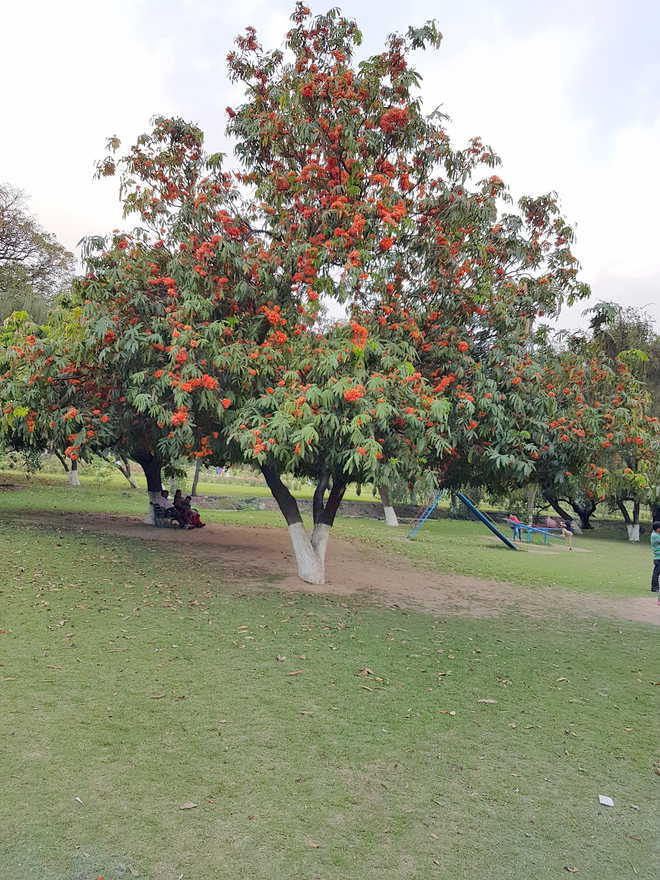Lt-Gen Baljit Singh (Retd)
As infernal forest fires consumed millions of trees in the lower and mid-Himalayan region of India, I recollected a poem titled Trees, composed in 1913 by a little-known American poet, thus:
“I think that I shall never see,
A poem lovely as a tree.
A tree whose hungry mouth is prest
Against the Earth’s sweet flowing breast.
A tree that looks at God all day,
And lifts his leafy arms to pray.
A tree that may in summer wear
A nest of Robins in her hair,
Upon whose bosom snow has lain
Who intimately lives with rain.
Poems are made by fools like me,
But only God can make a tree.”
—Alfred Joyce Kilmere.
sergeant Kilmer of the US Army had perished during a daring offensive action merely days before the culmination of the World War I but his poem lives on, forever. And one solitary tree which answers the spirit of his verse stands by his grave for posterity in one segment set aside for America’s bravehearts in the Central Park, New York.
Trees are one among primary symbiotic agents of planet Earth, the only living planet where the root systems of trees entwine into sponges both as checks against excessive soil erosion, and even more importantly for the subterranean storage of rain water. And of course, they are one among the major sources of timber, fuel, fodder and food, besides being the fundamental carbon-sinks, noise pollution absorbents and on ageing, they decompose in the natural cycle and in the process add to the top soil, which alone nurtures and sustains the green cover and agriculture.
As I dig into my photo-collection over the years to single out a few images, which showcase the poetic and aesthetic vibes of trees, my eyes are at once arrested by the images of two tree species, in particular, the Sita-Asoca and the Golden Tabebuia.
The Sita-Asoca tree (a native of India and South Asia) will no doubt conjure up at first a sense of Indian mythology but equally of our ancient recorded history, too. We are told that during the long exile and wanderings in Indian jungles of the Ayodhyan princes, Sita was simply charmed both by the thick-set clusters of orange, yellow, and scarlet flowers of this tree as also their lingering, delicate fragrance. When viewed more carefully, the purple anthers inside the crimson conical cup of the calyx and the six-to-eight bicoloured wiry stamens that burst out of each individual flower like fire-works are a divine sight. The new leaves are yet another attraction as these form into eight to ten inches long, pink-purple tassels which dangle like wind-chimes.
Besides, this evergreen tree, six to nine metre high looks like the most perfect hemisphere as its pendant leaves almost touch the ground. Man or beast standing beneath its canopy can scarcely be noticed. So to avoid Ravana’s gaze, harried Sita would spend much of the daylight hours under these trees and in the process link her name in perpetuity with this botanical species!
Eons later, when Queen Subhadrangi of Patliputra was expecting, she preferred to lie on a couch placed under the shade of this very tree, where she gave birth to Asoca. Hence the appropriate compound name Sita-Asoca, for this tree-species.
As for the Tabebuia Argentina, the tree is a native of Argentina but when, how, by whom and under what circumstances it got introduced to India, is a mystery. The indigenous tree, Indian laburnum comes close to match the Tabebuia in the abundance of yellow bloom but not quite the thick-set mass of pure gold of what in Argentina is called simply, the tree of gold!
Also, there is Homalium Tomentosum, which has a trunk rising straight as a lance and what is more eye-catching is the fact that it stands draped always, as if in spotless white tuxedo! And yet another species whose shape and the most delicate clusters of scarlet-pink flowers seem to challenge those of the Sita-Asoca.
What a shame that man-aided disasters and short-gain ‘development’ strategies should set aflame and uproot such tender creations of nature’s treasures. Let us on this World Environment Day rededicate ourselves to the pledge that trees are forever.
Unlock Exclusive Insights with The Tribune Premium
Take your experience further with Premium access.
Thought-provoking Opinions, Expert Analysis, In-depth Insights and other Member Only Benefits
Already a Member? Sign In Now











